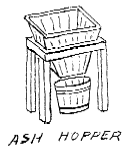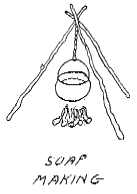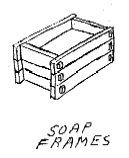
This booklet will provide persons interested in the ways of early American life some information about soap and soap making. Soap making is a homestead skill often forgotten in discussions of colonial days. Soap was of great value in keeping the household a far better place to live and work.
The manufacture of soap by the hard-working colonists from wood ashes and waste fats give testimony to early American self-sufficiency and resourcefulness. Soap, an easy item for us to obtain, was produced by boiling wood ash lye and fats together. Soap's desirability and procurement wrote its own pages in the history of early America.
The soap, in use during the years when the United States was a colony of England and then a young republic, was made from potash or pearlashes. This soap, which was potassium based, was generally the only kind made from the first discovery of soap making until the first half of the 19th century.
By far the most common soap was made from potash and pearlash. Potash and pearlash are forms of the potassium based alkali present in plant and wood material. Potash and pearlash soaps were used by everyone from the reigning monarchs to the peasant or cottager, who made their own soap from the waste fats and ashes they saved.
Soap in the American Colonies
At first the earliest settlers simply brought a plentiful supply of soap along with them. The Talbot, a ship chartered by the Massachusetts Bay Company to carry persons and supplies from England to its colonies at Naumbeak now known as Salem and Boston, listed among its cargo 2 firkins of soap. A firkin is an old measurement which was a wooden, hooped barrel of about nine gallon capacity. John Winthrop, who was to become the first governor of the Massachusetts Bay Colony, when writing to his wife in 1630 from Boston included soap in a list of necessities to be brought on her crossing to the New world.
After the colonists were settled and had been able to survive the first years of hardships, they found it more advantageous to make soap themselves using the copious amount of wood ashes, a natural result of their homesteading activities. With also a plentiful supply of animal fat from the butchering of the animals they used for food, the colonists had on hand all the ingredients for soap making. They did not have to rely on waiting for soap to be shipped from England and waste their goods or few pieces of currency in trade for soap

Soap with some work and luck could be made for free. Soap making was performed as a yearly or semiannual event on the homesteads of the early settlers. As the butchering of animals took place in the fall, soap was made at that time on many homesteads and farms to utilize the large supply of tallow and lard that resulted. On the homes or farms where butchering was not done, soap was generally made in the spring using the ashes from the winter fires and the waste cooking grease, that had accumulated throughout the year.
Before we discuss the soap making process we should explain what soap is and the chemical reaction that makes soap. No, this is not a chemical textbook. Some understanding of the chemistry involved, however, will enhance the story of soap's history.
Soap, in very simple chemical terms, is the sodium or potassium salt of a fatty acid. Sounds simple. And it is.
Common salt, which we all know as table salt, is not the only salt in the chemical world. There are many salts all being the result of an acid and an a alkali reacting together.
Acids are solutions that tend to burn or smart. Acids range from weak ones like acetic acid, the chief ingredient in vinegar, to hydrosulfuric acid, an extremely strong and dangerous acid in the battery of your car.
Alkali also called bases are solutions that corrode rather than burn. They too range from weak to strong. An example of a weak one is sodium bicarbonate, baking soda, used to settle your upset stomach caused by your over active stomach acid. A strong alkali is sodium hydroxide which is the chief ingredient in oven and drain cleaners. Actually oven and drain cleaners work by doing the very reaction we are discussing. They convert the grease blocking your drain or messing up your oven into soap so that you can flush or wipe it away.
Now let's go back to those fatty acids. Fatty acids are found in foods we call fats and oils. Today we hear much about fatty acids, as they are the substances effecting the nature of the fats and oils we eat and the action these foods have on our health.
Most products on the market today are not real soaps by the true definition but rather are detergents which have been created from petroleum based products. Other products, which called themselves soap, contain ingredients found in nature; but these ingredients have been radically changed by high energy processes. The resulting soap bears little similarity to the soap made historically down thru the ages.
Soap is not found in nature; but it can be created by very simple processes. In this way it is similar to bread, wine, glass, cheese, and pottery, other useful items produced by early peoples most likely by accident at first then by design.
Saponification is a very big chemical word for the rather complex but easy to create soap making reaction. Saponification is what happens when a fatty acid meets an alkali. When fats or oils, which contain fatty acids are mixed with a strong alkali, the alkali first splits the fats or oils into their two major parts fatty acids and glycerin. After this splitting of the fats or oils, the sodium or potassium part of the alkali joins with the fatty acid part of the fat or oils. This combination is then the potassium or sodium salt of the fatty acid. As we said at the start, this is soap.
Making of the wood ash lye.
Rendering or cleaning the fats.
Mixing the fats and lye solution together and boiling the mixture to make the soap.
In making soap the first ingredient required was a liquid solution of potash commonly called lye.
The lye solution was obtained by placing wood ashes in a bottomless barrel set on a stone slab with a groove and a lip carved in it. The stone in turn rested on a pile of rocks. To prevent the ashes from getting in the solution a layer of straw and small sticks was placed in the barrel then the ashes were put on top. The lye was produced by slowly pouring water over the ashes until a brownish liquid oozed out the bottom of the barrel. This solution of potash lye was collected by allowing it to flow into the groove around the stone slab and drip down into a clay vessel at the lip of the groove.

Some colonists used an ash hopper for the making of lye instead of the barrel method. The ash hopper, was kept in a shed to protect the ashes from being leached unintentionally by a rain fall. Ashes were added periodically and water was poured over at intervals to insure a continuous supply of lye. The lye dripped into a collecting vessel located beneath the hopper.
The preparation of the fats or grease to be used in forming the soap was the next step. This consists of cleaning the fats and grease of all other impurities contained in them.
The cleaning of fats is called rendering and is the smelliest part of the soap making operation. Animal fat, when removed from the animals during butchering, must be rendered before soap of any satisfactory quality can be made from it. This rendering removes all meat tissues that still remain in the fat sections. Fat obtained from cattle is called tallow while fat obtained from pigs is called lard.
If soap was being made from grease saved from cooking fires, it was also rendered to remove all impurities that had collected in it. The waste cooking grease being saved over a period of time without the benefits of refrigeration usually became rancid, This cleaning step was very important to make the grease sweeter. It would result in a better smelling soap. The soap made from rancid fats or grease would work just as well as soap made from sweet and clean fats but not be as pleasant to have around and use.
To render, fats and waste cooking grease were placed in a large kettle and an equal amount of water was added. Then the kettle was placed over the open fire outdoors. Soap making was an outside activity. The smell from rendering the fats was too strong to wish in anyone's house. The mixture of fats and water were boiled until all the fats had melted. After a longer period of boiling to insure completion of melting the fats. The fire was stopped and into the kettle was placed another amount of water about equal to the first amount of water. The solution was allowed to cool down and left over night. By the next day the fats had solidified and floated to the top forming a layer of clean fat. All the impurities being not as light as the fat remained in water underneath the fat.
You can observed this today in your own kitchen. When a stew or casserole containing meat has been put in the refrigerator, you can see the next day the same fat layer the colonists got on the top of their rendering kettle.
In another large kettle or pot the fat was placed with the amount of lye solution determined to be the correct amount. This is easier said than done. We will discuss it more later. Then this pot was placed over a fire again outdoors and boiled. This mixture was boiled until the soap was formed. This was determined when the mixture boiled up into a thick frothy mass, and a small amount placed on the tongue caused no noticeable "bite". This boiling process could take up to six to eight hours depending on the amount of the mixture and the strength of the lye.

Soap made with wood ash lye does not make a hard soap but only a soft soap. When the fire was put out and the soap mixture was allowed to cool, the next day revealed a brown jelly like substance that felt slippery to the touch, made foam when mixed with water, and cleaned. This is the soft soap the colonists had done all their hard to produce. The soft soap was then poured into a wooden barrel and ladled out with a wooden dipper when needed.
To make hard soap, common salt was thrown in at the end of the boiling. If this was done a hard cake of soap formed in a layer at the top of the pot. As common salt was expensive and hard to get, it was not usually wasted to make hard soap. Common salt was more valuable to give to the livestock and the preserving of foods. Soft soap worked just as well as hard and for these reasons the colonists, making their own soap, did not make hard soap bars.
In towns and cities where there were soap makers making soap for sale, the soap would be converted to the hard soap by the addition of salt. As hard bars it would be easier to store and transport. Hard bars produced by the soap maker were often scented with oils such as lavender, wintergreen, or caraway and were sold as toilet soap to persons living in the cities or towns.
Hard soap was not cut into small bars and wrapped as soap is sold today. Soap made by the soap makers was poured into large wooden frames and removed when cooled and hard.

The amount of soap a customer wanted was cut from the large bar. Soap was sold usually by the pound. Small wrapped bars were not available until the middle of the 19th century.
Another thought to remember is the soap making procedure described is not only how the homesteading colonial women made their soap. Soap making was generally a task the women did. This was essentially the method used by all soap makers of the period. Soap making was always considered one of the most difficult jobs on the farm or homestead.
The hardest part was in determining if the lye was of the correct strength, as we have said. In order to learn this, the soap maker floated either a potato or an egg in the lye. If the object floated with a specified amount of its surface above the lye solution, the lye was declared fit for soap making. Most of the colonists felt that lye of the correct strength would float a potato or an egg with an area the size of a ninepence (about the size of a modern quarter) above the surface. To make a weak lye stronger, the solution could either be boiled down more or the lye solution could be poured through a new batch of ashes. To make a solution weaker, water was added.
The difficulties in making soap the colonists endured arose from the lack of knowledge of the chemical processes involved and the inability to obtain lye's of known and dependable strengths. There were many superstitions which the colonist believe caused success or failure. For making good soap, the tide and the phases of the moon among other things were taken in account. A Pennsylvania Dutch recipe carefully warned that a sassafrasas stick was the only kind of implement suitable for stirring the soap and the stirring must be done always in the same direction.
In later colonial times, when the trade of soap making was well established in the cities and towns, many of these trades people became very astute observers of the process and were able to produce their soap with dependable high quality. However, many house holders, particularly in rural areas, made their own potash soap until the middle of the 19th century. There the difficulties and the related folklore still existed around the soap making process.
Soap making as a trade had grown in direct proportion with the growth of the colonies. Even in the very early days there were tradesmen making and selling soap, who were called soapboilers. Since tallow was the main ingredient for both soap and candles, many tradesmen were producers of both. These tradesmen were called chandlers. The first soapboilers arrived with the settling of Jamestown in 1609.
In New England also, we find signs of the early soap making trade. Christopher Gipson, who landed at Dorchester, Massachusetts in 1630, and then later in 1649 was elected Surveyor of the Highways of the Town of Boston, was a soapboiler. It is logical to conclude since it probably required then as now a source of money and influence to engage in politics Mr. Gipson's soap trade was keeping him in a comfortable style.
S6oapboilers included among their numbers Josiah Franklin, the
father of Benjamin Franklin.